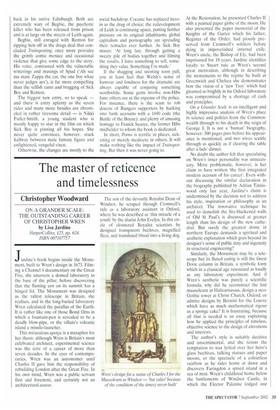The master of reticence and timelessness
Christopher Woodward
ON A GRANDER SCALE: THE OUTSTANDING CAREER OF CHRISTOPHER WREN by Lisa Jardine
HarperCoffins. £25, pp. 624, ISBN 007107757
Jardine's book begins inside the Monument, built to Wren's design in 1673. Filming a Channel 4 documentary on the Great Fire, she uncovers a domed laboratory in the base of the pillar, before discovering that the flaming urn on its summit has a hinged lid. The Monument was designed as the tallest telescope in Britain, she realises, and in the long-buried laboratory Wren calculated the parallax of the Earth. It is rather like one of those Bond films in which a fountain-pen is revealed to be a deadly blow-pipe, or the villain's volcanic island a missile-launcher.
This miraculous apercu is a metaphor for her thesis: although Wren is Britain's most celebrated architect, experimental science was the core of a career of more than seven decades. In the eyes of contemporaries, Wren was an astronomer until Charles II gave him the responsibility of rebuilding London after the Great Fire. In his own mind, Wren was a public servant first and foremost, and certainly not an architectural auteur. The son of the devoutly Royalist Dean of Windsor, he scraped through Cromwell's rule as a laboratory assistant in Oxford, where he was described as 'this miracle of a youth' by the diarist John Evelyn. In this circle of cloistered Royalist scientists he designed transparent beehives, magnified fleas, and transfused blood into a living dog.


























































 Previous page
Previous page